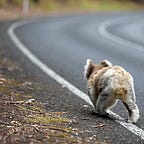Reconnecting Nature, Saving Species with Wildlife Corridors
Since the founding of our country, Americans have pushed West — Manifest Destiny … “Go west, young man ” … “The West is the best.” “How the West was Won” (both the movie and real life versions) was through pluck, luck, powerful determination and backbreaking labor. We ploughed and cleared across the country, ultimately connecting East to West through rail lines, and proceeded to “fill in” the country over the next 250 years.
In the course of that vast westward expansion, we managed to inflict mighty damage on the natural world. One shocking example was the near extinction of the buffalo, from an estimated population of 30 to 60 million prior to 1900. Fortunately, before we paved over all of paradise, “America’s Best Idea” — the development of America’s national parks system — came to fruition in the late 1800s and early 1900s.
The work of John Muir, known as the father of the American conservation movement, was key to the creation of Yosemite National Park and other national parks. Among the many other players we have to thank for the start of conserving the country’s natural spaces are President Teddy Roosevelt; Gifford Pinchot, head of the U.S. Forest Service; Interior Secretary James Rudolph Garfield; and Stephen Mather, the first National Park Service director. Under Roosevelt, 230 million acres were protected. Five national parks and the U.S. Forest Service were created, as well as bird and game preserves, national forests and national monuments. This established the mindset that created more preservation of open space in successive decades.
But what wasn’t part of the mix was connectivity. While we have a vast, impressive array of open spaces and public protected spaces, they are islands. The bison or wolf who steps out of Yellowstone can be shot. The animals, for some reason, don’t recognize our arbitrary borders. One area where the limitations to wildlife survival have been amplified in recent years is the Santa Monica Mountains in the highly human populated and densely built-out Southern California.
Home to a variety of wildlife, including mountain lions, the Santa Monica Mountains are an island to the wildlife who are cut off from safe movement by some of the busiest freeways in the country. These roads have claimed many lion lives, as the animals have tried to move. One now famous lion, P-22 — immortalized in Tony Lee Moral’s “The Cat that Changed America” — managed to cross two of these freeways and 20 lanes of traffic. P-22’s story inspired the plan, spearheaded by Beth Pratt Bergstrom of the National Wildlife Federation, to develop a wildlife crossing — the Liberty Canyon Wildlife Crossing — over the 101 freeway in SoCal.
This wildlife crossing is one of seven case studies in the newly released report, “Reconnecting Nature / How Wildlife Corridors Can Help Save Species,” prepared by the Environment America Research and Policy Center. When animals can’t relocate to seek new breeding opportunities, as with the cougars in the Santa Monica Mountains, there’s inbreeding and loss of genetic diversity, resulting in greater chances for birth defects and disease, according to the report. If this situation were to continue with the Santa Monica Mountain cougars, there’s as much as a 22 percent likelihood of that population being wiped out within the next 50 years. But providing a land bridge over the 101 freeway that would allow the population to leave their island, and for other cougars to come to the island, “would slash their extinction probability to 2.4 percent.”
Other examples outlined by the Environment America Research and Policy Center of how we can help restore nature — reconnect our wild spaces that have been fragmented by fencing, walls, towns, cities, roads and railroads — include dam removal in Washington that allowed fish populations to rebound; development of wildlife crossings in Wyoming to allow safer migratory crossing for animals, decreasing the number of vehicular-wildlife crashes; creation of more protected open spaces in New England and in the Appalachian forest to connect the biodiverse mountains of Eastern Kentucky with Tennessee and Virginia.
As stated in the “Reconnecting Nature” report in discussing grizzly bears in the Northern Rockies, these animals “need hundreds of square miles of habitat in order to feed, roam and mate.” Habitat is the essence of the requirements for all species, and that’s what Homo sapiens has increasingly denied other species while taking much for us. Ensuring we fix what we’ve broken by fragmenting ecosystems — stranding wildlife on islands — is an essential next step in conservation efforts across the country. Support at the local, state and federal levels is something all Americans should be able to get behind. Specifically at the federal level, as the Environment America Research and Policy Center recommends, Congress should enact the Wildlife Corridors Conservation Act.
Read more at Environment America.
Maria Fotopoulos writes about the connection between overpopulation and biodiversity loss. Contact her on FB @BetheChangeforAnimals and Pinterest at Animal Lives Matter.
